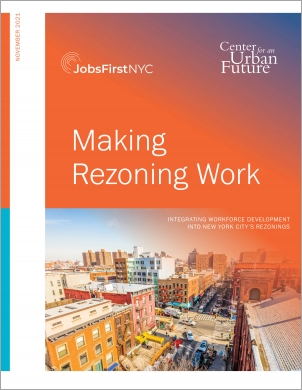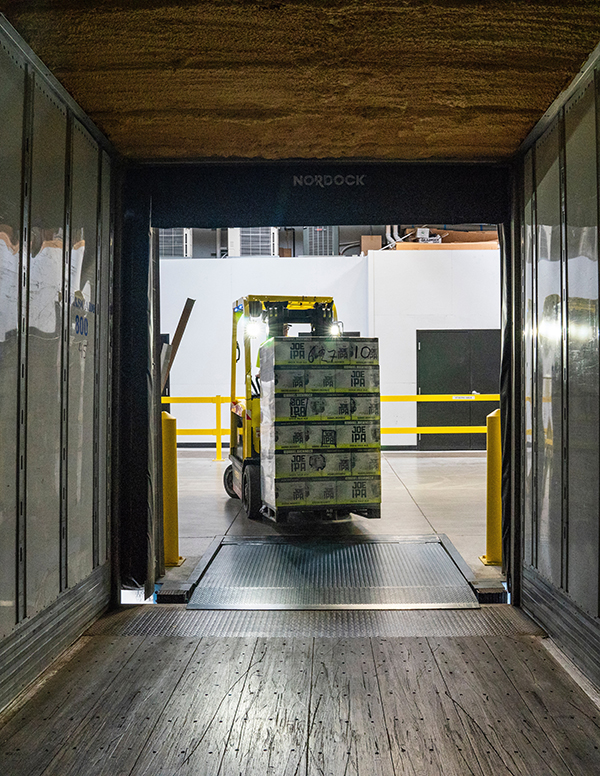Building a Citywide, Neighborhood-Based Workforce Investment Strategy for Future Rezonings
The next mayor should make coordinated workforce investments a top priority.
- Launch a comprehensive neighborhood-based workforce development strategy to build and strengthen local hiring and training networks and coordinate investments across agencies. Building strong local workforce networks and making coordinated investments in education and training at the community level should be a top priority for the city’s future leaders. The next mayor should convene every agency with a role in both neighborhood planning and workforce development—including the Department of City Planning, Economic Development Corporation, Small Business Services, Department of Education, and the Mayor’s Office of Workforce Development—and collaborate with workforce practitioners, local businesses, and community advocates to design a coordinated set of investments in education, training, and other workforce needs to take place in advance of major land-use changes. The resulting investment strategy should include specific timelines, reporting requirements, and funding amounts to ensure transparency and create accountability that extends beyond the limited updates available in the city’s current commitment tracker.
- Develop a local workforce network in every neighborhood with a poverty or unemployment rate higher than the city average—whether or not a rezoning is imminent. Every neighborhood with significant barriers to economic access should have a network of local organizations focused on identifying and responding to the neighborhood’s workforce challenges. But to date, networks focused on workforce development and job access only exist in a handful of communities, including the LESEN initiative on the Lower East Side and the YASEP network in the Bronx. As part of a broader strategy to cultivate an inclusive economic recovery, the next mayor should lead the development of local workforce networks to serve every community across the city with high rates of poverty and unemployment.
Workforce networks should look different in every neighborhood, depending on the job and training opportunities available locally and the needs of neighborhood residents. But each should include recurring annual funding for a dedicated coordinator position to liaise between businesses, training providers, community-based organizations, jobseekers, private developers, and city agencies. Strong networks can connect residents to jobs and training opportunities both inside and outside their own neighborhoods and help coordinate a community-wide response to future rezoning proposals.
The city and state should tap new revenue streams linked to development and dedicated to workforce investment.
- Establish citywide linkage fees for developers of market-rate commercial, residential, and industrial space, and use the proceeds to create an education and training fund for neighborhoods undergoing rezoning. Faced with an ongoing fiscal crisis stemming from the pandemic, public dollars for workforce development—already in short supply pre-COVID—are likely to be even more constrained. Boston’s Neighborhood Jobs Trust has allowed the city to tie economic and workforce development, creating a system that requires developers to make investments in workforce development. The next mayor should work with the State Legislature to pass similar legislation bringing this revenue model to New York City. For every square foot of new development, the developer would contribute $2 into a new Local Workforce Development Fund, seeding grants that would be used to build the capacity of quality local workforce providers in neighborhoods with new development.
A significant share of the fund should be distributed through RFPs for education and training programs in neighborhoods being rezoned—particularly bridge programs; programs that involve partnerships between local organizations and larger, reputable organizations outside of the neighborhood; paid internships and apprenticeships; programs that boost adult education, HSE attainment, and language acquisition; and programs with wraparound services to meet other basic needs, from childcare to MetroCards. As in Boston, developers should be allowed to choose whether their fee goes to a general education and training fund or to a training program that creates pathways for local residents to be hired on their projects. - Require developers and contractors with city contracts to partner with local workforce networks and pass community hiring legislation at the state level. The city should go beyond its current approach to local hiring mandates, which lack accountability and rarely result in new jobs for local residents. City leaders should work with the State to pass legislation requiring developers and contractors who do business with the city to meet local hiring goals. Provisions should include authorizing a minimum ratio of apprentices on building projects; requiring demonstrated partnerships with the local workforce organizations, including a first-look policy, in which the job advertisements are advertised with the local network first; and annual reporting requirements to create transparency around local hiring goals.
The next mayor and City Council should build and strengthen neighborhood-based workforce development capacity in advance of major land-use changes.
- Leverage public funding to incentivize long-term partnerships among community-based organizations and workforce development providers. The city should structure future RFPs to prioritize programs that develop partnerships among local workforce networks, incentivizing job training providers to work with community groups, libraries, and social services nonprofits on larger contacts. Bridge programs are especially well suited for partnerships: Community-based organizations can offer bridge programs created in partnership with larger, non-local providers, creating onramps for participants to transition into in-depth education or training programs. Funding should be allocated for multiple years in order to allow organizations to build strong partnerships, plan quality programs, refine their approach after running several cycles of the program, and gather data on effectiveness and outcomes that extend beyond initial job placement.
- Create a community toolkit for designing and planning workforce investments as part of any future zoning reform. To lay the groundwork for an inclusive and effective approach to workforce development in advance of any future rezoning, the city should work with community stakeholders and independent intermediary organizations to develop and launch a community toolkit for designing, planning, and advocating for strategic workforce investments. This toolkit should include several critical features, including data on a community’s workforce needs, a list of workforce investment options with associated costs, and asset maps identifying local workforce development and job training organizations, social services providers, and grassroots initiatives, along with the services they provide. The map should also include local skills-building infrastructure, such as community colleges, libraries, and city resources like Workforce1 Centers and JobsPlus programs in NYCHA housing. Maps should be translated into the neighborhood’s most common languages, and the city should be responsible for helping local organizations publicize them using LinkNYC kiosks, social media, and print advertisements, as well as using this mapping process to identify key investment needs.
- Set a goal of launching 5,000 new apprentices by 2025. The city currently has a modest goal of creating 450 new apprenticeship positions through the ApprenticeNYC program. This skills-building approach can help low-income New Yorkers access well-paying careers—learning an in-demand trade while earning a salary from day one—and could play a major role in expanding pathways to careers for residents of neighborhoods undergoing development. The next mayor should power up this initiative by setting an ambitious goal of launching 5,000 new apprentices by 2025. To ensure that this approach will help expand access to employment in neighborhoods undergoing new development, the next mayor should place particular focus on launching new apprenticeship programs in the industries poised to lead an economic rebound, including tech, healthcare, renewable energy, green infrastructure, and the creative industries. This new commitment should also include an expansion of pre-apprenticeship programs—especially in the building trades, where too few New Yorkers from low-income communities have been able to access the apprenticeship programs that currently exist.






